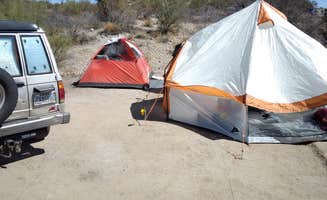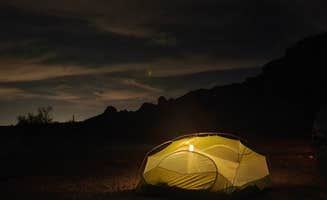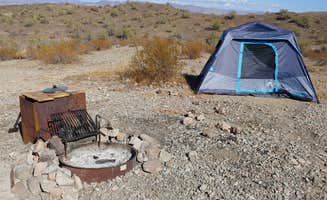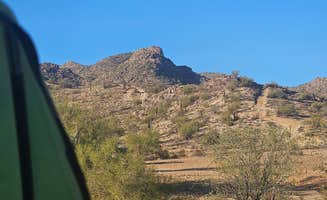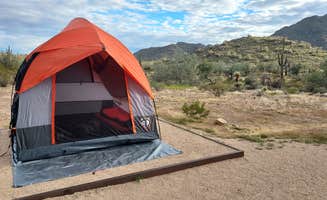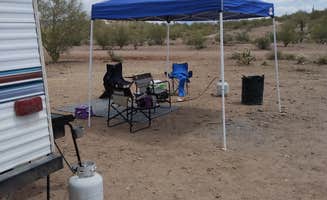Camping sites near Aguila, Arizona span elevations between 1,600 and 3,000 feet across Maricopa and La Paz counties. The region forms part of the transitional zone between Sonoran Desert lowlands and higher terrain of central Arizona. Winter temperatures generally range from 40-70°F, creating significantly more moderate conditions than summer's intense heat. Most access roads require careful navigation during monsoon season (July-September) when flash flooding can occur.
What to do
Rockhounding opportunities: Several camping areas near Aguila provide access to mineral collecting sites. At Saddle Mountain BLM (Tonopah, AZ), campers report good success finding interesting specimens. "We road our E bikes all over and did some agate hunting with wonderful success!" according to one visitor. The area is known particularly for chalcedony and agates.
Lake activities: The largest body of water in the region provides multiple recreation options. Alamo Lake State Park Campground offers fishing, boating, and shoreline exploration. As one camper noted, "I love taking my kayak because it's so quiet and it's a great lake for birding - I saw tons of migrating water birds this weekend, as well as an osprey, Harris hawks, and an owl early this morning."
Off-road exploration: The desert terrain supports extensive trail networks for motorized recreation. One visitor to Wayside Oasis RV Park shared, "We met some awesome people here that stay throughout the winter. They took us on some great rides. The bar and restaurant is awesome with good food and great staff." Side-by-side vehicles and ATVs are common throughout the region.
What campers like
Wildlife viewing: The desert ecosystem supports diverse animal species visitors can observe. At Alamo Lake State Park Campground, multiple campers mention wildlife encounters: "There are also tons of wild burros, coyotes, and other desert creatures." Another visitor cautions about one particular resident: "I fought a Badger twice a night for three nights. The Rangers are aware of the issue but obviously nothing has been done. The Badger I delt with was 20-25 pounds and nasty."
Astronomy opportunities: Limited light pollution creates exceptional night sky viewing from many camping locations. A camper at Ghost Town Road Camp described the experience: "Great spot plenty of private areas, pretty clean, amazing sunset, great scenery." The lack of nearby urban areas provides optimal conditions for stargazing during clear nights.
Solitude and quiet: Despite accessibility, many areas maintain a sense of isolation. A visitor to Eagle Eye Rd BLM reported, "the night was surprisingly extremely quiet, especially for a Friday night." This contrasts with busier camping areas closer to Phoenix or Wickenburg.
What you should know
Water availability limitations: Most dispersed camping areas require bringing all necessary water. A visitor to Constellation Park noted, "there is water across the street at the horse trough by the rodeo grounds. You can fill jugs, but there is not room to fill a trailer." For longer stays, planning water usage becomes essential.
Service connectivity varies: Cell reception fluctuates significantly across the region. At Eagle Eye Rd BLM, one camper reported, "Cell service is weak in this area. ATT was almost unusable, Verizon was a little better but still very weak." However, some areas provide better connections, with another camper sharing, "I had cell service close to the lake but at the RV site I did not get service (ATT)."
Trash management responsibilities: Most dispersed sites lack waste facilities. A camper at Eagle Eye Rd BLM observed, "There was so much garbage, diapers, appliances, etc that we expected people to drive up and dump some more trash at any minute." Visitors must pack out all waste materials or locate proper disposal sites in nearby communities.
Tips for camping with families
Site selection considerations: Choose locations carefully when camping with children. At Alamo Lake State Park Campground, one visitor recommended, "I prefer the B section because most of the sites have views of the lake, but section A has showers near the cabin rentals (they are only a short walk from B, so it makes staying closer to the lake a win still)." This setup provides both amenities and scenery.
Weather preparation essential: Temperature fluctuations require appropriate gear. A camper at Ghost Town Road Camp noted, "Watch out for coyotes if you have animals." Another visitor mentioned, "It was pretty hot, as would be expected here, but the breeze through the night was enough to keep us cooled off with the tent vents opened."
Educational opportunities: Several sites offer learning experiences about desert ecosystems and history. Constellation Park provides access to historical sites, with one visitor sharing, "We have camped many times with my family. Many people have RVs in our group and some have tents and truck tents! All are welcome and easy to navigate. Great for individuals and groups."
Tips from RVers
Leveling challenges: Terrain at many sites requires careful positioning. At Constellation Park, a visitor observed, "Most sites are not level. There are a few that can accomodate a class A. You can get water and dump at Fast Mart 76 about 9 miles away." Bringing leveling blocks proves essential at most dispersed sites.
Road condition awareness: Access routes require careful assessment before committing to them. A camper at Saddle Mountain BLM remarked, "You can get right up next to the mountain if you want. Very rocky though. I made it with a 35' skoolie. Just go slow." Another visitor advised, "Like any time your looking for a site, park in a safe place and search by either foot or in my case ebike."
Resource planning: Limited services mean bringing necessary supplies. Near Alamo Lake, a visitor cautioned, "The closest gas station is 45 minutes away. There is a shop up the road that sells 10 gallons in case of emergencies." Another camper recommended, "Bring everything with you, there isn't a store within 30 miles."



